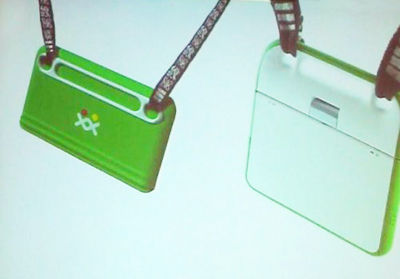Gen2 Hardware ideas
Jump to navigation
Jump to search
These are hardware ideas that were written on the XO-2 page, before it was "officially" maintained by OLPC.
Expected I/O Devices
- Speakers and camera almost certainly: Record is one of the most-used applications on the XO-1. (The kids in Peru asked for a flash; there are safety issues with that, though.)
- Mesh networking, yes. Not connected with USB! (since this is a big part of our suspend/resume troubles ATM.)
- Clear, clip-on rubberized keyboard that snaps over second screen showing through customized keyboard buttons but still allowing touch typing and emulating button presses on the touch screen.
Other features discussed
(although not necessarily by anyone on the design team)
- GPS (unknown whether this will be able to make the cost budget)
- This will not make the cost budget.
- Accelerometer (so that rotation is magic, not manual)
- Light sensor (so backlight level can be automatic for better power savings)
- Hinge-angle sensor (detect 'tablet mode' as well as 'closed')
- Hardware-protected RTC (bitfrost desiderata)
- Better protection for firmware FLASH, to avoid the possibility of bricking a machine if the power is removed at the wrong time.
- More open hardware design (schematic) -- this is really a contractual issue with the manufacturer
- More open software: we may not need an EC, and if we do we may be able to ensure its code is open. We may change the wireless device, and/or be able to switch to open firmware for it.
- Gigabit Ethernet port (for reliable networking among hundreds of laptops in a school)
- Power over Ethernet (so laptops charge while networked, in school)
- Should it have USB? USB is the worst part of the XO-1's power management architecture. But USB is also the main expansion port, to reflash, to add a keyboard or mouse, to get Ethernet, to power custom peripherals like medical monitors.
- Should it have an SD slot? It definitely needs a nonvolatile memory expansion strategy, and SD is reasonable. 8-bit-wide SD/MMC is twice as fast as the 4-bit-wide one in the XO-1.
- USB 3.0
- Stereo audio in?
- Stereo audio out?
- Integrated speakers? (They can also perhaps provide tactile feedback for the virtual keyboard, if designed to do so.)
- Stylus and stylus slot? Virtually every other touchscreen computer has one, for picking or writing with a stroke smaller than a blunt fingertip.
- Processor: not yet selected. It will almost certainly be a highly integrated System-on-Chip, so merely picking an architecture like "x86" or "ARM" isn't sufficient. Suggestions from the audience: Nvidia Tegra
- Battery? Solar cell! LiFePO4 seems to work pretty well in the XO-1. If OLPC could design a "standard" small LiFePO4 battery form factor, like a replacement for the AA that has an interruption-proof connector suitable for computers, it could become a standard worldwide in all sorts of electronics, such as flashlights. This would certainly help with spares!
- Software radio receiver? AM and shortwave, maybe FM, maybe analog TV, are probably doable for pennies. Kids can learn about radio and signal processing -- and have mass communication (AM radio) receivers.
- Software radio transceiver? An open WiFI chip would probably suffice for this.
- A 3G or WiMax module ???
